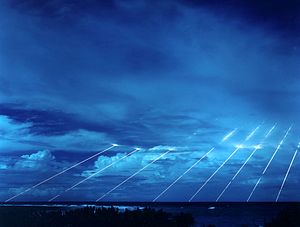Big news hit the front page of the New York Times on Saturday, in the form of a long article on China’s efforts to miniaturize its nuclear arsenal. The article, using the annual Pentagon report on Chinese military capabilities as its primary source, noted that the decision to tackle the technical problems associated with miniaturization suggest (but only suggest) a larger shift in nuclear weapons doctrine. As the Times article notes, China has long had the latent capacity to MIRV its nuclear missiles, a step that the United States, the Soviet Union, France, and the United Kingdom took long ago.
The Diplomat has closely followed developments in China’s policy of minimal nuclear deterrence, observing that while China had not yet decided to make the leap toward a nuclear warfighting strategy, the modernization and recapitalization of its force over the past decade could open the door to more offensive options.
Hans Kristensen has argued that this represents a major change in China’s nuclear posture, and a bad day for efforts at limiting the role that nuclear arms play in geopolitics. Others see this shift in more evolutionary terms, as holding to long-established technological red lines put clear limits on China’s ability to maintain a sophisticated deterrent. No one believes that France or the United Kingdom, which have long used MIRVs on submarine-launched ballistic missiles, seriously entertain the offensive use of nuclear weapons. Moreover, it’s worth noting that few American policymakers would even momentarily entertain enduring the level of nuclear insecurity that China lives with on a daily basis.
Does this decision come as a direct response to U.S. anti-ballistic missile efforts? Possibly, but these efforts have been in the works since the middle of last decade. Notably, U.S. efforts have yet to yield a workable defense system that an American president could entrust to defend against even a limited Chinese strike. Still, the notion that BMD loomed large in Chinese thinking can’t be discounted, and would suggest that China has only adjusted, and not fundamentally changed, its choice of deterrent posture.
The broader issue may be how China views the potential for long-term hostility between the U.S. and the PRC. While Americans are generally inclined to wildly overstate the importance of American behavior to the decision-making of foreigners, it can hardly be lost on Beijing that even the “dovish” party in the United States envisions a long-term period of confrontation. The Obama administration has even attempted to sell its primary multilateral economic effort, the TPP, on the grounds of security concerns about China.
There can be little question, however, that U.S. analysts who have long warned about China’s threat to the United States will feel vindicated by this report. It seems likely that the decision to MIRV will support, rather than deter, U.S. pursuit of missile defense systems, which in turn may push China towards a larger nuclear program (especially if China envisions an offensive warfighting doctrine). At some point, we’ll be forced to ask whether Washington and Beijing need to take another page from the Cold War rulebook, and consider bilateral nuclear limitation talks.

































